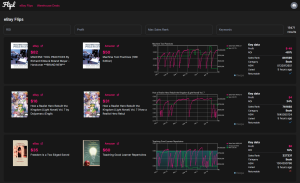Over the years, online shopping has become an essential part of commerce worldwide. After the COVID-19 pandemic, many people who were previously skeptical also started shopping online.
According to Statista, over 75% of American consumers are now shopping online. This presents a significant opportunity for those looking to make money by selling products online.
While selling different products online can be lucrative, the difference between success and failure often comes down to one key factor—profit margins. Many sellers focus on high-demand products, only to be caught in price wars with razor-thin profits. The real secret to sustainable online sales is identifying and selling high-margin products.
In this article, we will discuss how you can identify and sell high-margin products online.
Understanding High-Margin Products
Selling products online can be highly profitable, but not all products generate the same level of success. High-margin products are those that have a significant difference between the cost of sourcing and the final selling price. These are often unique items, difficult to source, or cater to a specific niche with limited competition.
Many sellers make the mistake of focusing solely on high-demand products without considering margins. A product that sells well but comes with high competition and low profitability can lead to wasted effort. Instead, the key is to find items for which people are willing to pay a premium. These products offer perceived value beyond their raw materials or function.
Yahoo! Finance has listed some examples of low-cost products that are not only in demand but also offer high-profit margins. Here are some products listed in the article:
- Home office products
- Kids apparel
- Matcha
- Pet care supplies
- Sunglasses
- Watches
- Leggings, etc.
Finding Profitable Niches
Identifying a niche with profitability potential requires a deep dive into consumer behavior and trends. Some of the best high-margin products belong to categories like luxury accessories, eco-friendly alternatives, and highly specialized tools or gadgets.
It is also important to decide whether you want to sell to businesses or end consumers. Businesses are usually willing to buy in bulk, which can improve their overall profit margins. For instance, businesses usually invest in specialized tools or software that help them improve efficiency.
Businesses in the corporate and retail sectors invest in operational efficiency tools like visitor management systems. Many companies use visitor management software to streamline office security and check-ins, along with CCTV cameras and other tools.
As stated by Greetly, using such solutions together can help make their workplace smarter and safer. For instance, they can use visitor management software as a self-service portal for visitors to register for entry. This can help streamline office operations and add a layer of security.
This kind of specialized solution demonstrates how businesses prioritize spending on tools that enhance convenience, compliance, security, branding, etc. Similarly, online sellers can capitalize on products that solve specific business or consumer problems in a way that justifies a higher price point.
Sourcing Products for Maximum Profit
Once a niche has been identified, the next step is to source products at the lowest possible cost without sacrificing quality. Private labeling, where sellers brand generic products as their own, can significantly increase perceived value.
According to Nielsen Consumer, private labeling has skyrocketed over the past years. It was the number one growth driver for over 50% of retailers in 2024. In 2023, private label sales accounted for close to 20% of the total FMCG value sales. Western Europe was leading this growth, with private label sales accounting for 36% of the total FMCG value sales that year.
Manufacturing custom versions of existing high-demand items can also help sellers differentiate their offerings and command higher prices. Direct relationships with manufacturers or wholesalers often provide better margins than drop shipping. While dropshipping is convenient, it tends to have lower profit potential due to higher competition and reliance on third-party suppliers.
Selling Strategies That Maximize Margins
The way a product is marketed can also impact its profit potential. High-margin products thrive on compelling branding and positioning. Instead of competing on price alone, sellers should focus on storytelling, exclusivity, and the problem-solving nature of their products.
Premium pricing strategies work particularly well when combined with an exceptional customer experience. This means optimizing product listings with high-quality images, persuasive descriptions, and social proof through reviews or influencer endorsements. Strategic upselling and bundling can further increase profitability by encouraging customers to purchase complementary items.
Frequently Asked Questions
How do I identify a profitable niche for high-margin products?
Look for markets with a high degree of specialization or where customers are prepared to pay more for a problem-solving solution. Consider sectors that need specialized or customized goods, including healthcare, technology, or environmentally friendly substitutes. To identify opportunities, study competition pricing, investigate customer behavior, and monitor new trends.
How do I ensure my high-margin products stand out from competitors?
Pay attention to your value proposition and branding to make your high-margin items stand out. Provide a unique feature, improved customer support, or an enhanced user experience that rivals don’t offer. High-quality content marketing, distinctive packaging, and first-rate customer service may enhance your product and sustain a higher price.
Should I focus on high-margin products in any particular category?
High-margin items can be found in any category. However, sectors such as technology, home automation, luxury goods, and health and wellness typically feature products with more potential for profit. These sectors usually serve customers who value innovation, uniqueness, and quality. This enables vendors to charge more for goods that satisfy those demands.
Sellers must constantly adjust to consumer tastes and market movements in order to maintain profitability. It takes constant research and innovation to keep ahead of the competition since high-margin items today could not be as profitable in a year. Sellers may ensure they are continually providing worthwhile items at the proper price by utilizing data analytics and consumer feedback.
Finding the proper product is only one aspect of successful online selling. Other strategies include comprehending customer psychology, streamlining supply chains, and developing a brand that can charge higher pricing. Profitable e-commerce will be at the forefront for those who understand these components.








